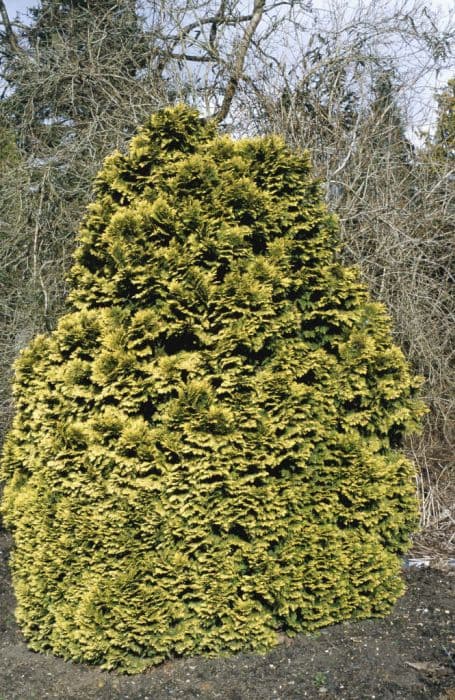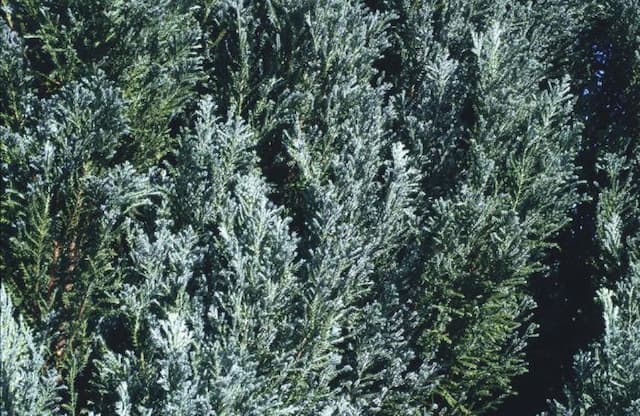Japanese Cedar Cryptomeria japonica 'Elegans Viridis'

ABOUT
The Japanese cedar 'Elegans Viridis' is a visually striking evergreen conifer with a lush green color that forms the backdrop to its soft, finely textured foliage. The leaves of this cultivar often appear needle-like with an elegant, almost feathery quality, giving it a gentle, graceful appearance. During the colder months, the normally green foliage doesn't change to the bronze color typical of the parent species, but rather retains its vibrant green hue throughout the seasons, making it a standout in a winter garden. The plant's overall form is pyramidal, with the branches spreading outwards as they ascend, creating a tiered effect that is both aesthetically pleasing and provides depth to the visual structure of the plant. The bark, while not as prominently displayed as the foliage, has a rugged texture that contrasts nicely with the softness of the leaves. Cones may appear as the plant matures, but they are often small and inconspicuous compared to the foliage. Overall, the Japanese cedar 'Elegans Viridis' presents a lush, full-bodied appearance that embodies both elegance and vitality, making it a favored choice for ornamental planting.
About this plant
 Names
NamesFamily
Cupressaceae.
Synonyms
Japanese Cedar, Japanese Cryptomeria, Sugi.
Common names
Cryptomeria japonica 'Elegans Viridis'.
 Toxicity
ToxicityTo humans
Japanese Cedar is generally not known to be toxic to humans. There are no commonly reported symptoms of poisoning from ingestion of this plant since it's not typically ingested for any dietary or medicinal purposes. However, like many plants, it could potentially cause irritation or an allergic reaction if the foliage or sap comes into contact with skin or if particles are inhaled.
To pets
Japanese Cedar is not considered highly toxic to pets. However, ingestion of the plant might lead to mild gastrointestinal upset like vomiting or diarrhea. There are no severe toxic reactions commonly known. If a pet ingests a large quantity of the plant, it's always a good idea to consult with a veterinarian.
 Characteristics
CharacteristicsLife cycle
Perennials
Foliage type
Evergreen
Color of leaves
Green
Height
15-20 feet (4.5-6 meters)
Spread
10-15 feet (3-4.5 meters)
Plant type
Tree
Hardiness zones
5-9
Native area
Japan
Benefits
 General Benefits
General Benefits- Ornamental Value: Adds aesthetic appeal to gardens with its unique, feathery foliage and pyramidal shape.
- Low Maintenance: Requires minimal pruning and is relatively easy to care for once established.
- Drought Tolerance: Adapts to various conditions and can withstand periods of drought once mature.
- Year-Round Interest: Evergreen nature ensures greenery throughout all seasons, adding consistency to the landscape.
- Erosion Control: Its extensive root system can help stabilize slopes and prevent soil erosion.
- Habitat Support: Provides shelter and nesting sites for birds and other wildlife.
- Windbreak: Acts as a natural wind barrier when planted in rows or groups.
- Privacy Screen: Dense foliage offers a privacy screen, making it suitable for hedging or as a garden backdrop.
- Shade Provider: Its size and foliage can offer shade in garden areas, reducing local temperature and sun exposure.
- Cultural Significance: Holds cultural importance in Japan and can add an element of foreign or exotic design to gardens.
 Medical Properties
Medical PropertiesThis plant is not used for medical purposes.
 Air-purifying Qualities
Air-purifying QualitiesThis plant is not specifically known for air purifying qualities.
 Other Uses
Other Uses- Woodworking: Cryptomeria, also known as Japanese Cedar, is commonly used in making small wooden items such as boxes, buckets, and chopsticks due to its easy-to-work-with nature and aromatic scent.
- Horticultural Art: The flexible branches of Cryptomeria allow it to be used in the art of bonsai, creating miniaturized trees that mimic the shape and style of full-size trees.
- Erosion Control: The robust root system of Cryptomeria helps stabilize soil on slopes and prevent erosion, making it useful for landscaping in erosion-prone areas.
- Privacy Screens: Due to its dense foliage, Cryptomeria is often planted in rows to create natural privacy screens or living fences between properties.
- Urban Green Spaces: Cryptomeria's tolerance to pollution and compact growth habit make it suitable for urban parks and gardens, providing greenery in city environments.
- Traditional Roofing: In Japan, Cryptomeria wood is traditionally used for roofing shingles known as "hiwada" that are valued for their durability and weather resistance.
- Acoustic Instruments: The wood of Cryptomeria is sometimes used in the making of string instruments, such as koto and shamisen, providing a resonant quality to the sound.
- Sustainable Forestry: Cryptomeria is cultivated for timber in sustainable forestry practices, offering an alternative to slower-growing hardwoods.
- Carbon Sequestration: As a fast-growing tree, Cryptomeria can absorb carbon dioxide effectively, contributing to carbon sequestration efforts when planted in large numbers.
- Religious Symbolism: In Shinto shrines, Cryptomeria trees are often planted for their symbolic purity and are associated with sacred spaces in Japan.
Interesting Facts
 Feng Shui
Feng ShuiThe Japanese Cedar is not used in Feng Shui practice.
 Zodiac Sign Compitability
Zodiac Sign CompitabilityThe Japanese Cedar is not used in astrology practice.
 Plant Symbolism
Plant Symbolism- Longevity and Timelessness: Cryptomeria, commonly known as Japanese Cedar, is known to live for hundreds of years, symbolizing endurance and the ability to withstand the test of time.
- Enduring Strength: Its wood is resistant to rot and insects, representing strength and resilience in the face of adversity.
- Sacredness: Often found in temple gardens and sacred spaces in Japan, Japanese Cedar is associated with sanctity and spiritual significance.
- Peace and Tranquility: With its evergreen foliage and towering presence, Japanese Cedar is often seen as a symbol of peace and a provider of tranquil refuge.
- Good Fortune: In Japanese culture, the Japanese Cedar is sometimes considered to bring good luck and prosperity.
 Water
WaterThe Japanese Cedar requires consistent moisture, so it's important to water it regularly, especially during dry spells. A good rule of thumb is to provide about 1 to 1.5 gallons of water per week, adjusting for rainfall, to ensure the soil remains moist but not waterlogged. During hot summer months, water twice a week, and during the winter, reduce watering to every couple of weeks, depending on the weather and soil dryness. Ensure that the water is distributed evenly around the base of the tree, extending to the edge of the plant's canopy where the root system is likely to be.
 Light
LightThe Japanese Cedar thrives best in full sun to partial shade conditions. The ideal spot for this plant is an area where it receives at least 4 to 6 hours of direct sunlight each day, preferably morning light with some afternoon shade. Avoid deep shade locations since insufficient light can lead to sparse foliage and a less vigorous plant.
 Temperature
TemperatureJapanese Cedar prefers a temperate climate and can handle temperatures as low as -20°F and as high as 90°F. However, the ideal temperature range for fostering healthy growth is between 60°F and 70°F. This plant is quite hardy and can adapt to cooler climates, but it's important to protect it from harsh winter winds which can dry out the foliage.
 Pruning
PruningPruning the Japanese Cedar is generally done for shaping and removing any dead or damaged branches to maintain the health of the plant. Prune in late winter or early spring before new growth starts, as this is the best time when the tree is dormant. Light trimming can be done annually, but heavy pruning should be done sparingly and only as needed to not stress the plant.
 Cleaning
CleaningAs needed
 Soil
SoilJapanese Cedar 'Elegans Viridis' requires a soil mix with good drainage, consisting of equal parts loam, peat, and sharp sand. Maintain soil pH between 5.0 and 7.0 for optimal growth.
 Repotting
RepottingJapanese Cedar 'Elegans Viridis' typically needs repotting every 3-5 years or when root bound to ensure continued growth and health.
 Humidity & Misting
Humidity & MistingJapanese Cedar 'Elegans Viridis' thrives in average ambient humidity, preferably between 40-60%, but can adapt to lower humidity levels outdoors.
 Suitable locations
Suitable locationsIndoor
Place in bright light, ensure high humidity, and avoid dry heat.
Outdoor
Plant in well-draining soil, full sun to partial shade, shelter from harsh winds.
Hardiness zone
Japanese Cedar 'Elegans Viridis' is suited for USDA zones 5-8.
 Life cycle
Life cycleCryptomeria japonica 'Elegans Viridis', commonly known as Japanese cedar, begins its life as a small seed, which, once germinated, grows into a seedling with a primary root and juvenile foliage. As it matures into a sapling, the plant develops a woody stem and a foliage that becomes more dense and vibrant green in color. Eventually, the sapling enters the adult stage, growing into a large, evergreen coniferous tree that can reach considerable heights. The tree then produces cones, the male releasing pollen and the female producing seeds. Pollination occurs, typically assisted by the wind, allowing for fertilization and the development of new seeds within the female cones. These seeds then disperse, completing the cycle, and giving rise to new plants when they find suitable conditions for germination.
 Propogation
PropogationPropogation time
Late winter to early spring
The Japanese cedar, Cryptomeria japonica 'Elegans Viridis', is commonly propagated by seed or cuttings, with cuttings being the most popular method due to the maintenance of cultivar characteristics. To propagate by cuttings, the best time is late summer to early autumn, specifically August to September. Cuttings should be taken from semi-hardwood, which is the current year's growth that has begun to harden. Typically, 4 to 6 inch long cuttings are most effective. Remove the lower needles and dip the base of the cutting into a rooting hormone powder or solution before inserting it into a well-draining potting mix. The cuttings then need to be placed in a high humidity environment, with temperatures around 70°F (21°C), and kept moist until rooting occurs, generally in a few weeks to a couple of months.









